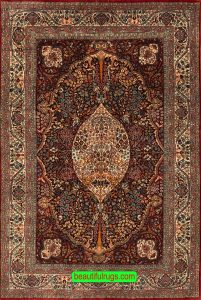Want To Know How To Spot A Fake Antique Persian Rug?

How to Spot a Fake Antique Persian Rug
When investing in home décor, many people hesitate to spend on rugs because it can feel unworthy to spend thousands of dollars on something that will inevitably get walked on and may suffer spills. However, an antique Persian rug can be an excellent investment. These handmade rugs are designed for both style and functionality, and they are incredibly durable. They add charm to any room, instantly transforming its appearance and ambiance. Additionally, their value tends to appreciate over time. Purchasing a Persian rug now means you can either pass it down through generations as a cherished heirloom or sell it years later for a significant profit.
The challenge lies in ensuring that you are buying an authentic rug. With the rising popularity of Oriental rugs, including Persian rugs, there has been an increase in counterfeit products. So, how can you determine whether the Persian rug you want to buy is genuine? Fortunately, distinguishing a fake from a real Persian rug isn’t as complicated as you might think. Here are a few steps to help you identify authenticity.
Look for Signs that the Antique Persian Rug is Handmade.
When shopping for antique Persian rugs, look for signs that indicate whether the rug is handmade or machine-made. Handwoven rugs are true works of art, created by artisans who weave intricate patterns that are visible on both the front and the back of the rug. To determine authenticity, examine the back of the rug; if the pattern on the back mirrors that of the front, it is likely genuine. Conversely, if the rug has a plastic backing, it is a clear indication that it is mass-produced or fake.
Discover the Origin of the Antique Persian Rug
There is a common misconception that Oriental rugs and Persian rugs are the same; however, this is not true. While Persian rugs are indeed a type of Oriental rug, they are exclusively made in Iran. If rugs made in other countries are marketed as Persian, they are imitations. Handwoven rugs from Pakistan, India, Afghanistan, or Turkey are beautiful in their own right, but they are classified as Oriental rugs, not Persian.
Check for a Soft Underside on the Antique Persian Rug.
When examining an antique Persian rug, one crucial aspect to consider is the texture of its underside. Authentic Persian rugs are unique in that they are crafted without any additional backing. This absence of backing contributes to their distinctive soft underside, which sets them apart from many commercially produced rugs.
In contrast, mass-produced rugs often feature synthetic pile materials and plastic backing, designed to hold the fibers together and provide a more rigid structure. This can result in a less comfortable feel and a lack of the natural beauty that characterizes genuine Persian craftsmanship.
By looking for the soft underside of a Persian rug, you can gain valuable insight into its authenticity and quality. A true antique Persian rug not only showcases intricate designs and vibrant colors on the surface but also delivers a tactile experience that reflects its luxurious heritage. Thus, checking the underside is an essential step in ensuring you’re purchasing a genuine piece of artistry rather than a mass-manufactured imitation.
Look for Signs of Faux-Sging in the Antique Persian Rug.
When searching for a genuine Antique Persian rug, it is essential to be aware of the signs of faux-aging, a technique that some less scrupulous rug stores employ to create the illusion that a rug is old or antique. Faux-aging typically involves methods such as acid-washing, which gives the rug a deliberately faded, washed-out appearance. While this might initially seem appealing, it’s important to remember that true antique Persian rugs are known for their vibrant colors, which can remain remarkably vivid for centuries. In fact, if you were to place a genuine antique next to a faux-aged rug, the authenticity would shine through, revealing a richness and vitality that the faux counterpart simply cannot replicate.
To ensure you invest in an authentic Persian rug, it’s vital to purchase from a reputable dealer specializing in these exquisite pieces. For example, Beautiful Rugs is renowned for offering some of the best antique Persian rugs in Chicago. We pride ourselves on sourcing our rugs directly from skilled artisans and trusted sellers in Iran, ensuring that every piece in our collection possesses exceptional quality, meticulous construction, and exquisite craftsmanship.
As you explore our extensive rug gallery, you’ll discover a diverse array of designs, colors, and sizes, each with its own unique story and character. Whether you’re looking to enhance your home decor or invest in a timeless piece of artistry, our collection is sure to impress. Visit us to learn more about the rich history and cultural significance of these remarkable rugs, and let us help you find the perfect addition to your space.